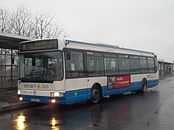Irisbus Agora
| Irisbus Agora | |
|---|---|
|
| |
| Overview | |
| Manufacturer | Renault, Irisbus |
| Body and chassis | |
| Doors | 2, 3 or 4 |
| Floor type | Low-floor |
| Powertrain | |
| Engine |
Renault MIDR 062045 |
| Power output |
186 kW (249 hp) (Renault) |
| Transmission |
Voith DIWA 3-speed automatic |
| Dimensions | |
| Length | 11,990 mm (472.0 in) (Agora S) |
| Width | 2,500 mm (98.4 in) |
| Height | 2,924 mm (115.1 in) |
| Curb weight | 11,380 kg (25,090 lb) |
The Irisbus Agora (previously known as Renault Agora, Karosa City Bus or Ikarus Agora) was a low-floor bus designed and built by Renault from 1996 to 2002, date upon which it has been built by Irisbus, firstly a joint-venture with Fiat subsidiary Iveco from 1999, with Iveco engines. It has also been built by Czech-based Karosa under the Citybus name as a diesel-powered bus, and Skoda as a trolleybus in Eastern European markets (Škoda 24Tr Irisbus and Škoda 25Tr Irisbus.
Standard Agora buses have been used by Athens bus operator OASA in two versions: diesel and CNG.
The range consisted of:
- Standard 12-metre "S" version, available in two- or three-door form
- Articulated 18-metre "L" version in three- or four-door form
- "Line" 12-metre version in two- or three-door form (built from 1999). This version is distinct from the standard Agora by its engine layout, which is longitudinally-mounted (under the rear passenger seats) instead of being transverserly mounted in the Agora S and L. That gives the Line version a slightly greater seating capacity and a better fuel economy over the S version.
- Intercity version called "Moovy" (unveiled in 2003) which was based on the Agora Line.
Gallery
-
A Standard (S) Irisbus Agora in Strasbourg, France.
See Also
| Wikimedia Commons has media related to Renault Agora. |
| ||||||||||||||
| ||||||||||




